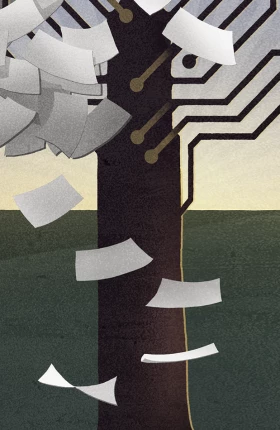Despite being under assault on multiple fronts, journalism remains a noble profession that is essential to democracy and free markets. With journalists facing personal threats and professional discredit, we wanted to understand why they continue to do their work. What keeps them in a profession where they endure serious business uncertainty and relentless Orwellian accusations that they generate “fake” news and have partisan motives?
The sine qua non of healthy media companies is a healthy workforce, starting with the industry’s producers, the journalists themselves. So we surveyed journalists to discover their ambitions, frustrations, and fears. We were reassured to find that they are relatively optimistic about the future of their profession, despite the current hostile environment. On the basis of our work with media organizations over the past decade, we share their optimism.
The news media business will continue to struggle as it strives to meet investor expectations, compete against digital news outlets and aggregators, and ward off political attacks from the US president and others. But it’s not going away.
Journalism has a number of options for survival that are more promising than the pessimists would have you believe. To be sure, news organizations have more work to do in The New News on Print Media Transformation. But the effective strategies used by for-profit entities such as the New York Times and the Wall Street Journal to build digital subscription and marketing businesses provide a model that outlets with clear voices, compelling content, and engaging audience experiences can aim to replicate.
And although not-for-profit business and funding models remain in their infancy, the success of the Texas Tribune, the Philadelphia Inquirer, the VT Digger in Vermont, and others suggests an alternative not-for-profit model to sustain high-quality journalism. Public radio—the not-for-profit news medium that inspired the for-profit podcast explosion—continues to grow. Foundations, philanthropists, and even digital giants such as Google and Facebook recognize that journalism is too valuable to society to be left entirely to the whims of the market.
The Harsh Realities of the Industry
The macro view of the business of journalism is not encouraging. Most publicly traded US newspaper stocks languish in the bottom quartile of five-year performance. Nearly 20% of local daily and weekly newspapers in the country have closed since 2014. More than 2,000 counties do not have a daily newspaper.
Consumers have been much less willing to pay for digital journalism than for video or audio content. The subscriber bases of Netflix and Spotify, for example, dwarf the number of online subscribers to the New York Times or the Washington Post.
Apart from financial concerns, the industry faces a credibility problem brought on not only by a hostile US president but also by general distrust of social media channels, which young consumers use as their main pathways for receiving news. In a 2018 Pew Research Center survey, 57% of social media users said they expect the news they see on social media to be largely inaccurate.
It has also become more dangerous to be a journalist in the US. In 2018, 42 journalists were physically attacked while working, and 5 were killed. This year, through June 2019, 10 US journalists have been attacked.
The Muted Optimism of Journalists
Against this sobering backdrop, journalists are realistic and relatively upbeat about their profession. We recently surveyed about 400 full-time journalists who broadly reflect the profession’s composition by gender, race, tenure, and market size. They provided us with responses to a range of questions about the state of the industry.
They recognize the threats. In our survey, 54% of participants identified publishers’ focus on revenue over journalistic mission as being among the biggest threats to their profession. Almost as many participants— 53%—cited propaganda or public relations output dressed up as news. (See Exhibit 1.) Despite these concerns, 59% of survey participants said that they anticipate staying in the profession for the foreseeable future. While only a third of journalists with less than five years of professional journalistic experience expressed that view, 62% of those with five to ten years experience and 67% of the most experienced journalists considered themselves to be in the profession for the long haul. (See Exhibit 2.)
They are guardedly positive. In general, journalists are fairly bullish on the future of journalism. Nearly two-thirds of survey participants expressed optimism about the profession. Men tended to be more optimistic than women, with 34% of male journalists saying they were “very optimistic,” compared with 22% of female journalists. The most optimistic were journalists with five to ten years of experience, those who work in radio, podcasting, or television, and those who work in smaller markets. For example, 67% of small-market journalists said that they were optimistic or very optimistic about the profession, compared with 59% of large-market journalists. (See Exhibit 3.) Even if a news outlet were to fail, nearly half of survey respondents—and an even larger share among those with five to ten years of experience—believe that an entrepreneurial journalist could make a living covering his or her market.
A Roadmap for the Future
Traditional forms of journalism remain vibrant. Newspapers such as the New York Times, the Washington Post, and the Wall Street Journal are showing that consumers will pay for high-quality online journalism. We believe that other online outlets with distinct coverage and a clear voice can also generate revenues from consumers.
Often, however, journalism has benefited from various forms of subsidy, support, and benevolence. It’s probably not coincidental that historically the Times, the Post, and the Wall Street Journal were family controlled and operated, with motives and missions other than simply maximizing profit. A new generation of billionaires, including Jeff Bezos, Patrick Soon-Shiong, and Marc Benioff, appear to be stepping into a similar role in their ownership of the Washington Post, the Los Angeles Times, and Time magazine, respectively.
During the heyday of US television in the 1960s and 1970s, the entertainment side of the major commercial networks supported the news side, and Federal Communications Commission licensing limited competition. The BBC, one of the most enduring global journalism brands, is largely funded through an obligatory consumer television licensing fee. In the US, the Corporation for Public Broadcasting represents a smaller version of publicly funded broadcasting, providing grants to public media entities.
So while journalism outlets have historically operated as businesses, they have not operated solely as businesses. The Tampa Bay Times, for example, has been owned by a nonprofit organization for more than 40 years, a structure that ProPublica, the Marshall Project, the Philadelphia Inquirer, and others have adopted more recently. Organizations such as the Knight Foundation, NewsMatch, and the Institute for Nonprofit News provide funding to newsrooms, and increasingly they are doing so at the local level, where the need is most acute. Google and Facebook, whose aggregation efforts have contributed to some of journalism’s troubles, have each pledged $300 million to promote journalism.
These efforts represent an extension of historical measures of support given to a crucial profession when for-profit opportunities available for certain types of news coverage or select markets simply are not working. It may be hard to imagine state-funded media playing a BBC-like role in the US, but other creative forms of support, sponsorship, and promotion are certainly within reach.
One option might be for benefactors or crowd-sourced investors to fund individual journalists, concentrating their support on a particular talent rather than spreading it across a whole enterprise. Think of it as Kickstarter for journalists. Or imagine a town or an interest group— for example, environmentalists—endowing a fellowship that supports the work of a journalist.
Nearly half of the journalists surveyed believe that not-for-profit funding models will emerge as viable alternatives to help keep journalism afloat. This belief is strongest among male, younger, and large-market journalists. Many potential models exist. Journalists are fairly evenly divided about whether converting businesses to not-for-profit status, obtaining crowd funding, or seeking contributions from nonprofit foundations is the best option for sustainable journalism. (See Exhibit 4.) Considerably fewer journalists favor state funding.
Such possibilities seem quite reasonable as a way to serve communities that are now news deserts—and they would be good both for the profession and for local communities. Academic literature shows that reading the news improves civic engagement and that corporations are less likely to pollute and engage in other negative behaviors in communities that have a strong press. Many other public or not-for-profit models are possible to sustain news coverage and the profession in areas where the for-profit model simply cannot work.
We do not have any final answers, but we care deeply about the questions and conversation that are necessary to help create options that will enable journalists to continue to speak truth to power. Journalism is too important to fail.










